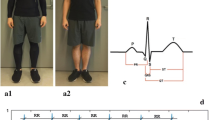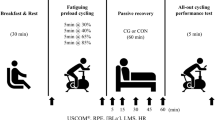Abstract
Purpose
The aim of the current study was to examine the impact of lower body compression garments (CG) on cardiac autonomic control of heart rate (HR) prior to, during and following submaximal exercise.
Methods
Thirty (15 males, 15 females) healthy, active adults undertook consecutive 10-min stages of supine rest, moderate–intensity upright cycling and supine recovery while wearing either normal clothing (CONTROL) or normal clothing plus CG tights in a randomised order. Heart rate (HR) and rating of perceived exertion (RPE) were assessed every minute while cardiovascular autonomic responses were assessed during the final 5 min of each stage via HR variability (HRV). The change in HR at 1-min (HRR1) and 2-min (HRR2) post-exercise and the time constant of HR recovery (HRtau) were assessed as indices of cardiac autonomic reactivation. Differences between variables were assessed via repeated measures ANOVA and corrected pairwise comparisons.
Results
Compared to rest, exercise resulted in a reduction of HRV that was similar for CONTROL and CG. A main effect for condition was identified for one non-linear, long-term HRV variable only with a significantly lower value (61.4 ± 47.8 vs. 67.1 ± 50.2 ms, p < 0.05) for CG compared to CONTROL. Cardiac autonomic reactivation (HRR1, 42.0 ± 16.8 vs. 45.5 ± 13.4 bpm; HRR2, 58.9 ± 10.5 vs. 58.9 ± 8.2 bpm; HRtau, 63.4 ± 22.3 vs. 65.1 ± 23.0 s, p > 0.05) was comparable for CONTROL and CG.
Conclusion
Lower body CG failed to alter most cardiac autonomic responses during rest, moderate-intensity exercise or recovery. Mechanisms for potential ergogenic benefits of CG remain to be characterised.

Similar content being viewed by others
Abbreviations
- α1:
-
Short-term fractal scaling exponent
- α2:
-
Long-term fractal scaling exponent
- CG:
-
Compression garments
- HF:
-
High (0.15–0.4 Hz)-frequency component of HRV
- HR:
-
Heart rate
- HRR1:
-
Change in heart rate during the first minute of recovery
- HRR2:
-
Change in heart rate during the first 2 min of recovery
- HRtau :
-
Time constant of heart rate change during recovery
- HRV:
-
Heart rate variability
- La:
-
Capillary blood lactate
- LF:
-
Low (0.04–0.15 Hz) frequency component of HRV
- LF/HF:
-
Ratio of low to high frequency components of HRV
- ms:
-
Milliseconds
- nu:
-
Normalised units
- pNN50:
-
Percentage of successive normal-normal RR intervals different by more than 50 ms
- RPE:
-
Rating of perceived exertion
- RMSSD:
-
Root mean square of successive differences in normal-normal RR intervals
- SampEn:
-
Sample entropy
- SD1:
-
Short axis of the Poincare plot—short-term instantaneous RR modulation
- SD2:
-
Long axis of the Poincare plot—long-term RR modulation
- SDNN:
-
Standard deviation of all normal–normal RR intervals
References
Ballmann C, Hotchkiss H, Marshall M, Rogers R (2019) The effect of wearing a lower body compression garment on anaerobic exercise performance in Division I NCAA basketball players. Sports 7(6).
Berry MJ, McMurray RG (1987) Effects of graduated compression stockings on blood lactate following an exhaustive bout of exercise. Am J Phys Med 66(3):121–132
Borg GA (1982) Psychophysical bases of perceived exertion. Med Sci Sports Exerc 14(5):377–381
Broatch JR, Bishop DJ, Halson S (2018) Lower limb sports compression garments improve muscle blood flow and exercise performance during repeated-sprint cycling. Int J Sports Physiol Perform 13(7):882–890
Brown F, Gissane C, Howatson G, van Someren K, Pedlar C, Hill J (2017) Compression garments and recovery from exercise: a meta-analysis. Sports Med 47(11):2245–2267
da Cruz CJG, Porto LGG, da Silva RP, de Souza PD, Garcia GL, Molina GE (2019) Impact of heart rate on reproducibility of heart rate variability analysis in the supine and standing positions in healthy men. Clinics (Sao Paulo) 74:e806
Dascombe BJ, Hoare TK, Sear JA, Reaburn PR, Scanlan AT (2011) The effects of wearing undersized lower-body compression garments on endurance running performance. Int J Sports Physiol Perform 6(2):160–173
Driller MW, Halson SL (2013) The effects of wearing lower body compression garments during a cycling performance test. Int J Sports Physiol Perform 8(3):300–306
Duffield R, Edge J, Merrells R, Hawke E, Barnes M, Simcock D, Gill N (2008) The effects of compression garments on intermittent exercise performance and recovery on consecutive days. Int J Sports Physiol Perform 3(4):454–468
Duffield R, Cannon J, King M (2010) The effects of compression garments on recovery of muscle performance following high-intensity sprint and plyometric exercise. J Sci Med Sport 13(1):136–140
Dupuy O, Douzi W, Theurot D, Bosquet L, Dugue B (2018) An evidence-based approach for choosing post-exercise recovery techniques to reduce markers of muscle damage, soreness, fatigue, and inflammation: a systematic review with meta-analysis. Front Physiol 9:403
Engel FA, Holmberg HC, Sperlich B (2016) Is there evidence that runners can benefit from wearing compression clothing? Sports Med 46(12):1939–1952
Fecchio RY, Brito L, Leicht AS, Forjaz CLM, Pecanha T (2019) Reproducibility of post-exercise heart rate recovery indices: a systematic review. Auton Neurosci Basic Clin 221:102582
Garber CE, Blissmer B, Deschenes MR, Franklin BA, Lamonte MJ, Lee IM, Nieman DC, Swain DP, American College of Sports M (2011) American College of Sports Medicine position stand. Quantity and quality of exercise for developing and maintaining cardiorespiratory, musculoskeletal, and neuromotor fitness in apparently healthy adults: guidance for prescribing exercise. Med Sci Sports Exerc 43(7):1334–1359
Geldenhuys AG, Swart J, Bosch A (2019) Investigation of the impact of below-knee compression garments on markers of exercise-induced muscle damage and performance in endurance runners: a prospective randomized controlled trial. Sports Health 11(3):254–264
Goto K, Mizuno S, Mori A (2017) Efficacy of wearing compression garments during post-exercise period after two repeated bouts of strenuous exercise: a randomized crossover design in healthy, active males. Sports Med Open 3(1):25
Harty PS, Zabriskie HA, Erickson JL, Molling PE, Kerksick CM, Jagim AR (2018) Multi-ingredient pre-workout supplements, safety implications, and performance outcomes: a brief review. J Int Soc Sports Nutr 15(1):41
Heiss R, Hotfiel T, Kellermann M, May MS, Wuest W, Janka R, Nagel AM, Uder M, Hammon M (2018) Effect of compression garments on the development of edema and soreness in delayed-onset muscle soreness (DOMS). J Sports Sci Med 17(3):392–401
Horiuchi M, Takiguchi C, Kirihara Y, Horiuchi Y (2018) Impact of wearing graduated compression stockings on psychological and physiological responses during prolonged sitting. Int J Environ Res Public Health 15(8)
Leicht AS, Hirning DA, Allen GD (2003) Heart rate variability and endogenous sex hormones during the menstrual cycle in young women. Exp Physiol 88(3):441–446
Leicht AS, Sinclair WH, Patterson MJ, Rudzki S, Tulppo MP, Fogarty AL, Winter S (2009) Influence of postexercise cooling techniques on heart rate variability in men. Exp Physiol 94(6):695–703
Leicht AS, Crowther RG, Golledge J (2011) Influence of peripheral arterial disease and supervised walking on heart rate variability. J Vasc Surg 54(5):1352–1359
MacRae BA, Cotter JD, Laing RM (2011) Compression garments and exercise: garment considerations, physiology and performance. Sports Med 41(10):815–843
Maestri R, Pinna GD, Porta A, Balocchi R, Sassi R, Signorini MG, Dudziak M, Raczak G (2007) Assessing nonlinear properties of heart rate variability from short-term recordings: are these measurements reliable? Physiol Meas 28(9):1067–1077
Maruyama T, Mizuno S, Goto K (2019) Effects of cold water immersion and compression garment use after eccentric exercise on recovery. J Exerc Nutr Biochem 23(1):48–54
Mizuno S, Arai M, Todoko F, Yamada E, Goto K (2017) Wearing compression tights on the thigh during prolonged running attenuated exercise-induced increase in muscle damage marker in blood. Front Physiol 8:834
Mujika I, Halson S, Burke LM, Balague G, Farrow D (2018) An integrated, multifactorial approach to periodization for optimal performance in individual and team sports. Int J Sports Physiol Perform 13(5):538–561
Patwardhan AR, Evans JM, Bruce EN, Eckberg DL, Knapp CF (1995) Voluntary control of breathing does not alter vagal modulation of heart rate. J Appl Physiol 78(6):2087–2094
Pierpont GL, Stolpman DR, Gornick CC (2000) Heart rate recovery post-exercise as an index of parasympathetic activity. J Auton Nerv Syst 80(3):169–174
Piras A, Gatta G (2017) Evaluation of the effectiveness of compression garments on autonomic nervous system recovery after exercise. J Strength Cond Res 31(6):1636–1643
Rimaud D, Calmels P, Pichot V, Bethoux F, Roche F (2012) Effects of compression stockings on sympathetic activity and heart rate variability in individuals with spinal cord injury. J Spinal Cord Med 35(2):81–88
Scanlan AT, Dascombe BJ, Reaburn PR, Osborne M (2008) The effects of wearing lower-body compression garments during endurance cycling. Int J Sports Physiol Perform 3(4):424–438
Sear JA, Hoare TK, Scanlan AT, Abt GA, Dascombe BJ (2010) The effects of whole-body compression garments on prolonged high-intensity intermittent exercise. J Strength Cond Res 24(7):1901–1910
Sperlich B, Haegele M, Kruger M, Schiffer T, Holmberg HC, Mester J (2011) Cardio-respiratory and metabolic responses to different levels of compression during submaximal exercise. Phlebology 26(3):102–106
Varela-Sanz A, Espana J, Carr N, Boullosa DA, Esteve-Lanao J (2011) Effects of gradual-elastic compression stockings on running economy, kinematics, and performance in runners. J Strength Cond Res 25(10):2902–2910
White DW, Raven PB (2014) Autonomic neural control of heart rate during dynamic exercise: revisited. J Physiol 592(12):2491–2500
Zinner C, Pelka M, Ferrauti A, Meyer T, Pfeiffer M, Sperlich B (2017) Responses of low and high compression during recovery after repeated sprint training in well-trained handball players. Eur J Sport Sci 17(10):1304–1310
Acknowledgements
The authors would like to thank SKINS™ (Australia) for their generous donation of compression garments; and Brett Fforde, Lewan Parker and the numerous students who assisted with this study.
Author information
Authors and Affiliations
Contributions
AL and FN conceived and designed the study with AL collecting/analysing the data. All authors (AL, MA, FN) interpreted results, wrote the manuscript, and approved the final manuscript.
Corresponding author
Ethics declarations
Conflict of interest
The authors declare that they have no conflict of interest.
Ethical approval
The current study was conducted in accordance with the laws of Australia and the National Statement on Ethical Conduct in Human Research by the National Health and Medical Research Council. All procedures were conducted in accordance with the approval of the James Cook University Human Research Ethics Committee (H3451).
Additional information
Communicated by Massimo Pagani.
Publisher's Note
Springer Nature remains neutral with regard to jurisdictional claims in published maps and institutional affiliations.
Rights and permissions
About this article
Cite this article
Leicht, A.S., Ahmadian, M. & Nakamura, F.Y. Influence of lower body compression garments on cardiovascular autonomic responses prior to, during and following submaximal cycling exercise. Eur J Appl Physiol 120, 1601–1607 (2020). https://doi.org/10.1007/s00421-020-04391-9
Received:
Accepted:
Published:
Issue Date:
DOI: https://doi.org/10.1007/s00421-020-04391-9




